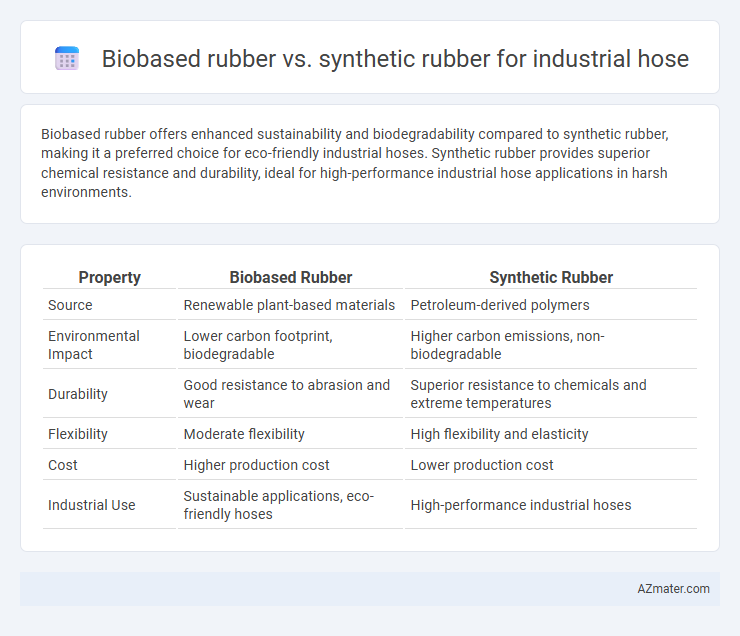Biobased rubber offers enhanced sustainability and biodegradability compared to synthetic rubber, making it a preferred choice for eco-friendly industrial hoses. Synthetic rubber provides superior chemical resistance and durability, ideal for high-performance industrial hose applications in harsh environments.
Table of Comparison
| Property | Biobased Rubber | Synthetic Rubber |
|---|---|---|
| Source | Renewable plant-based materials | Petroleum-derived polymers |
| Environmental Impact | Lower carbon footprint, biodegradable | Higher carbon emissions, non-biodegradable |
| Durability | Good resistance to abrasion and wear | Superior resistance to chemicals and extreme temperatures |
| Flexibility | Moderate flexibility | High flexibility and elasticity |
| Cost | Higher production cost | Lower production cost |
| Industrial Use | Sustainable applications, eco-friendly hoses | High-performance industrial hoses |
Introduction to Industrial Hoses
Industrial hoses designed for fluid transfer and material handling are increasingly incorporating biobased rubber due to its sustainable properties and reduced environmental impact. Biobased rubber offers comparable flexibility, chemical resistance, and durability to synthetic rubber, making it suitable for applications requiring resilience under varying temperatures and pressures. Selecting the appropriate material depends on operational requirements, with biobased rubber promoting eco-friendly innovation while synthetic rubber remains preferred for extreme chemical or abrasion resistance in industrial settings.
Overview of Biobased Rubber
Biobased rubber, derived from renewable natural sources such as guayule and dandelion plants, offers a sustainable alternative to traditional petroleum-based synthetic rubber in industrial hose manufacturing. It provides comparable mechanical strength, elasticity, and chemical resistance while reducing carbon footprint and dependency on fossil fuels. Increasing demand for eco-friendly materials drives innovation in biobased rubber formulations optimized for industrial hose applications.
Overview of Synthetic Rubber
Synthetic rubber, primarily derived from petroleum-based monomers such as styrene-butadiene and nitrile butadiene, offers consistent performance, high durability, and excellent resistance to abrasion, chemicals, and temperature fluctuations, making it ideal for industrial hose applications. Its uniform molecular structure ensures predictable mechanical properties and long service life, supporting harsh industrial environments like oil, gas, and chemical processing industries. Advances in synthetic rubber formulations continue to enhance flexibility, strength, and environmental resistance compared to biobased alternatives.
Key Properties Comparison
Biobased rubber offers superior environmental sustainability and enhanced elasticity, making it an excellent choice for industrial hoses requiring flexibility and biodegradability. Synthetic rubber provides higher resistance to heat, oil, and chemicals, ensuring durability and long service life in harsh industrial environments. Comparing tensile strength, abrasion resistance, and thermal stability highlights synthetic rubber's robustness, whereas biobased rubber excels in eco-friendly applications and moderate mechanical performance.
Environmental Impact Analysis
Biobased rubber in industrial hoses significantly reduces carbon footprint by utilizing renewable resources, lowering greenhouse gas emissions compared to petroleum-derived synthetic rubber. Lifecycle assessments show biobased rubber offers enhanced biodegradability and less ecological toxicity, minimizing soil and water contamination risks. Industrial hose manufacturers increasingly adopt biobased rubber to meet stringent environmental regulations and promote sustainability in supply chains.
Performance in Industrial Applications
Biobased rubber for industrial hoses offers enhanced environmental sustainability with comparable tensile strength and abrasion resistance to synthetic rubber, making it suitable for moderate to high-pressure applications. Synthetic rubber maintains superior chemical resistance and durability under extreme temperatures and aggressive media, ensuring longer service life in demanding industrial environments. Performance optimization in industrial hoses depends on the specific application requirements, with synthetic rubber favored for heavy-duty use and biobased rubber chosen where eco-friendly solutions and moderate performance parameters align.
Cost and Economic Considerations
Biobased rubber for industrial hoses typically incurs higher initial costs due to limited production scale and raw material availability compared to synthetic rubber, which benefits from established manufacturing processes and global supply chains. Over time, synthetic rubber offers better cost predictability and economies of scale, making it more economically viable for large-scale applications. However, rising environmental regulations and consumer demand for sustainability may enhance the economic attractiveness of biobased rubber through potential incentives and long-term cost savings.
Durability and Lifespan
Biobased rubber for industrial hoses offers enhanced environmental sustainability but may exhibit slightly lower durability and lifespan compared to synthetic rubber, which is engineered for superior resistance to abrasion, chemicals, and extreme temperatures. Synthetic rubber hoses typically withstand harsh industrial conditions longer, providing extended service life and reduced maintenance costs. Advancements in biobased rubber formulations are closing the gap, though synthetic variants remain the preferred choice for demanding durability requirements.
Regulatory and Safety Standards
Biobased rubber for industrial hoses complies with stringent environmental regulations such as REACH and RoHS, minimizing toxic chemical use and ensuring biodegradability, which supports sustainability goals. Synthetic rubber meets established industry safety standards like ASTM D2000 and ISO 1827, providing proven chemical resistance and durability under high pressure and temperature conditions. Regulatory trends increasingly favor biobased materials to reduce carbon footprint and hazardous emissions, making compliance with evolving safety and environmental protocols a critical factor in material selection.
Future Trends in Industrial Hose Materials
Biobased rubber is gaining traction in industrial hose manufacturing due to its renewable sources and reduced environmental impact compared to traditional synthetic rubber, which relies on petroleum-based compounds. Advances in biotechnology and polymer science are driving innovations in biobased rubber formulations that enhance durability, flexibility, and chemical resistance, positioning them as viable alternatives for industrial applications. Future trends indicate a growing demand for sustainable materials in industrial hoses, emphasizing biodegradability, lower carbon footprints, and compliance with stricter environmental regulations.

Infographic: Biobased rubber vs Synthetic rubber for Industrial hose
 azmater.com
azmater.com